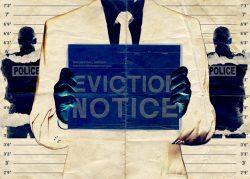A City Council Committee hearing held to gauge the state of evictions since the moratorium ended six weeks ago revealed an influx of filings is threatening to overwhelm legal aid providers.
Anna Aboody, a staff attorney at legal nonprofit Mobilization for Justice in the Bronx, compared the flood of cases to the scores of Covid patients entering understaffed hospitals at the height of the pandemic.
“Unlike the overburdened ERs and ICUs who had no control over the number of people requiring care, the Office of Court Administration does not and should not be carrying on as if it had no choice but to calendar as many new cases as possible,” Aboody said.
Courts have turned to scheduling cases for tenants who have yet to secure a lawyer, which the attorney called a “misplaced urgency,” rather than prioritizing those in which both parties have counsel.
Data from the state’s court system show about 18,000 cases have been filed since the start of the year, far below the over 43,000 filed in the first two months of 2020, before the moratorium began.
However, Jesenia Ponce, supervising attorney at the Northern Manhattan Improvement Corporation, said those new filings are adding to a backlog of more than 200,000 cases stayed throughout the pandemic.
Attorneys and advocates argued that pushing cases forward when the tenant hasn’t found a lawyer is undermining the effectiveness of Right to Counsel, a program the city expanded last year to guarantee free legal representation to all low-income tenants.
“We want to be clear that we expect the court to adjourn each case until a tenant has been connected to a lawyer,” said N’Jelle Murphy, tenant leader with the Flatbush Tenant Coalition.
Read more


Another issue: Local Law 53, which requires the city to work with advocacy groups to educate tenants on their access to Right to Counsel. The legislation, signed by then-Mayor Bill de Blasio last May, has yet to be “fully implemented,” according to tenant attorneys and advocates.
Laura Springer, a tenant leader with Catholic Migration Services, said the city allocated $3.6 million toward the law for outreach, money community organizations have yet to see.
Councilmember Diana Ayala, who chairs the Committee on General Welfare, said she was not aware that the law had not been implemented.
Other attorneys criticized the accessibility of city-funded rent relief and housing vouchers, testifying that red tape is putting more tenants at risk of a court-ordered eviction.
Although tenants may still apply for the emergency rental assistance program to secure up to a year of eviction protection, ERAP is out of money and new funding has yet to be secured.
As a stop-gap, nonprofits are advising renters to apply for One Shot Deal, a city program that offers temporary loans to those facing eviction. But those advocates argue the program’s rules are preventing many renters from securing aid.
Marika Dias, an attorney at the Urban Justice Center, said the city should cut the requirement that tenants must prove their ability to pay rent later down the line and increase available funding. The program typically doles out about $150 million annually; by comparison, ERAP exhausted all $2 billion of its funding and needs another $2 billion to satisfy pending applications.
Although the city and state expanded their housing voucher programs last year to federal Section 8 levels, advocates said strict requirements and processing delays have prevented qualified applicants from securing housing through so-called CityFHEPS vouchers, which places some of those tenants at risk of displacement.
Kathleen Keller, a staff attorney at the Legal Aid Society, called on the city to eliminate the rule that tenants must have lived in the shelter system for three months or have received an eviction notice to qualify. She also said the city should make the program accessible to all rent-burdened New Yorkers making below 200 percent of the federal poverty line “to really address the [eviction] crisis” and streamline the application process.
